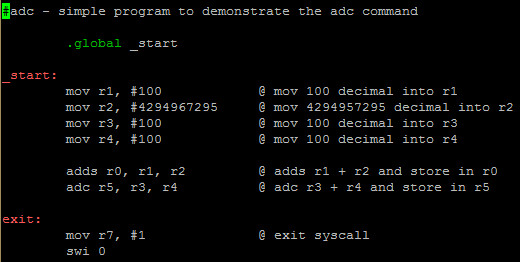Part 20 – ADC
For a complete table of contents of all the lessons please click below as it will give you a brief of each lesson in addition to the topics it will cover. https://github.com/mytechnotalent/Reverse-Engineering-Tutorial
ADC is the same as ADD except it adds a 1 if the carry flag is set. We need to pay particular attention to the CPSR or Status Register when we work with ADC.
Let’s look at an example to illustrate:
We add 100 decimal into r1, 4,294,967,295 into r2, 100 decimal into r3 and 100 decimal into r4. We then add r1 and r2 and place in r0 and then add r3 and r4 and place into r5.
We see adds which sets the flags in the CPSR. We have to once again remember when we debug in GDB, the value of the CPSR is in hex. In order to see what flags are set, we must convert the hex to binary. This will make sense as we start to debug and hack this example in the coming tutorials.
You can compile the above by:
as -o adc.o adc.s ld -o adc adc.o
I want you to ask yourself what is going to happen when r3(100 decimal) is added to r4(100 decimal)? What do you think the value of r5 will be with the above example of setting the flags with the adds result? Think about the first sentence in this tutorial and keep this in mind for the next tutorial.
Next week we will dive into Debugging ADC.
